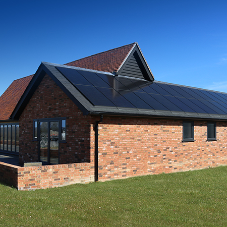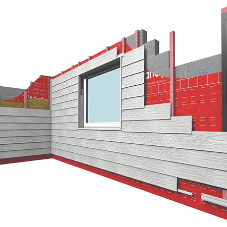A blog written by Marley
What is the difference between a cavity fire barrier and a fire-stop?
Cavity fire barriers and fire-stops are two types of passive fire protection that can slow or stop the spread of flames and smoke in a fire situation. But what is the difference between them?
These two phrases are sometimes used interchangeably. For example, the NHBC recommendations for pitched roofs refer to fire-stops and cavity barriers as fire-stopping measures. Indeed, both product types can stop or slow the spread of fire and smoke; however, if you’re looking to distinguish between the two terms:
1. A cavity fire barrier fills concealed internal gaps within walls, ceilings and other parts of a building.
2. Fire-stops typically fill visible gaps around openings or joints in fire-resistance rated walls.
Now, let’s look at cavity barriers and fire-stops in more detail.
What is a cavity fire barrier?
Approved Document B of the Building Regulations defines a cavity barrier as a construction, other than a smoke curtain, which:
1. closes a concealed space against penetration of smoke or flame; or
2. restricts the movement of smoke or flame within such a space.
These barriers are used to form a complete seal between different areas of a home. Without them, experts say that fires can spread five to ten times faster through a building.
What is a fire-stop?
Fire-stops create a seal around openings and between joints, helping to maintain the fireproofing of a wall or floor assembly and preventing the spread of fire and smoke.
The Structural Timber Association (STA) explains that fire-stops close a gap or imperfection in a fire-resisting element of a structure or compartment lining. They should have at least the same fire resistance as the function requirement in which they are located.
In addition, the STA says that fire-stops can achieve cavity barrier functions if they are used to close a cavity. However, a cavity barrier is not considered a fire-stop unless it is designed for that function.
Preventing the spread of fire in roofs
Cavity barriers and fire-stops are critical elements in preventing the spread of smoke and fire, especially in the compartmentation of multi-occupancy buildings, such as terraced homes, semi-detached houses and blocks of flats. These products are often suitably specified within the liveable areas of a building, but fire protection often falls short when it comes to the roof.
In recent years, there have been several cases of fires spreading between homes in multi-occupancy buildings due to inadequate cavity barriers and fire-stops in the roof. In many of these cases, the party walls between properties had adequate protection between the lower levels; but that protection did not extend into the roof void, allowing fire and smoke to travel easily between properties.
Extending the cavity fire barriers and fire-stops through the entire height of the house, including the roof void and roof construction, is essential for preventing the spread of fire and smoke between adjoining properties.
Specifying roof cavity barriers
Marley Roof Defence provides a complete solution for fireproofing the roof space between homes.
Roof Defence forms a fire-resistant barrier below the roof and ridge tiles and above the party walls or spandrel panels below the roof covering. In the event of a fire, Roof Defence’s intumescent material will expand to close the gap between the top of the wall/spandrel panel and the roof tiles. It also separates the roof batten and ridge tile timbers.
The result is effective fire resistance for 60 minutes, depending on the non-combustibility of the roof tiles and the construction of the party wall.
To find out more about fire stops and cavity fire barriers within the roof space, please contact Marley’s technical support team.
What is the difference between a cavity fire barrier and a fire-stop? [Blog]
| T | (01283) 722588 |
|---|---|
| E | info@marley.co.uk |
| W | Visit Marley's website |
| Lichfield Rd, Branston, Burton-on-Trent, Staffs, DE14 3HD |
Products by this Company
Categories
Fire protection Cavity barriers Pitched roofs





